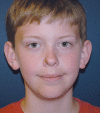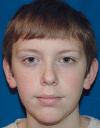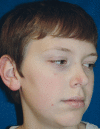Successful reconstruction of complex pediatric nasal lesions: improving outcomes using dermal regenerative templates
- PMID: 25289301
- PMCID: PMC4173827
- DOI: 10.1097/GOX.0000000000000033
Successful reconstruction of complex pediatric nasal lesions: improving outcomes using dermal regenerative templates
Abstract
Background: Dermal regenerate templates are currently widely used in both adult and pediatric burn reconstruction. Despite this, the safety and efficacy of regenerate templates combined with full-thickness skin grafts for the reconstruction of pediatric facial defects traditionally treated with local flaps is not widely published. The aim of this study is to report the safety and efficacy of pediatric nasal defect reconstruction using regenerative templates/full-thickness skin grafts.
Methods: A retrospective review of one institution's experience with pediatric nasal defects treated with regenerative templates was performed. All patients (n = 4) were treated with a multistage protocol. Two reviewers independently assigned Visual Analogue Cosmetic Scale (VACS) scores: 1 surgeon and 1 nonsurgical researcher not involved in patient care. Standardized photographs (anteroposterior, oblique, lateral, and worm's eye view) were assigned VACS scores according to a 100-point scale: "abhorrent," 0-24; "poor," 25-49; "moderate," 50-74; and "excellent," 75-100. Statistical analysis was performed using Mann-Whitney U and Wilcoxon paired signed-rank tests.
Results: Four patients (2 boys and 2 girls, average age 6.8 yr) who met the inclusion criteria were identified. A total of 5 nasal lesions (2 spitz nevi, 1 vascular lesion, and 2 congenital nevi) were removed. The preoperative VACS score was 45.2 (range, 5-70), compared with 84.5 (range, 45-100) postoperatively (P <0.000). There was no significant difference between raters (preoperative, P = 0.346; postoperative, P = 0.678).
Conclusions: The reconstruction of complex pediatric nasal lesions using dermal regenerative templates and full-thickness postauricular skin grafts is safe and effective, and associated with low morbidity and significant improvement in VACS scores.
Figures








Similar articles
-
Skin Grafts vs Local Flaps for Reconstruction of Nasal Defects: A Retrospective Cohort Study.JAMA Facial Plast Surg. 2015 Jul-Aug;17(4):270-3. doi: 10.1001/jamafacial.2015.0444. JAMA Facial Plast Surg. 2015. PMID: 26021837
-
Full-thickness skin grafts for surgical defects of the nasal ala - a comprehensive review, approach and outcomes of 186 cases over 9 years.Br J Dermatol. 2014 May;170(5):1106-13. doi: 10.1111/bjd.12792. Br J Dermatol. 2014. PMID: 24329782
-
Secondary reconstruction of burned nasal alae using rolled dermal flap with overlying full-thickness skin graft.Eur Ann Otorhinolaryngol Head Neck Dis. 2011 Jan;128(1):1-6. doi: 10.1016/j.anorl.2010.10.005. Epub 2011 Jan 13. Eur Ann Otorhinolaryngol Head Neck Dis. 2011. PMID: 21236747
-
Advances in addressing full-thickness skin defects: a review of dermal and epidermal substitutes.Regen Med. 2018 Jun;13(4):443-456. doi: 10.2217/rme-2017-0047. Regen Med. 2018. PMID: 29985763 Review.
-
Preliminary results in single-step wound closure procedure of full-thickness facial burns in children by using the collagen-elastin matrix and review of pediatric facial burns.Burns. 2015 Sep;41(6):1268-74. doi: 10.1016/j.burns.2015.01.007. Epub 2015 Feb 21. Burns. 2015. PMID: 25716758 Review.
Cited by
-
The Use of Biologic Wound Agents in Pediatric Reconstructions.Semin Plast Surg. 2022 Feb 25;36(1):48-52. doi: 10.1055/s-0042-1742748. eCollection 2022 Feb. Semin Plast Surg. 2022. PMID: 35706562 Free PMC article. Review.
-
Use of Integra for Reconstruction after Nevi Resection: A Systematic Review and Pooled Analysis of Reported Cases.Surg Res Pract. 2019 Oct 9;2019:9483627. doi: 10.1155/2019/9483627. eCollection 2019. Surg Res Pract. 2019. PMID: 31687472 Free PMC article. Review.
-
Integra's legacy unveiled: expert panel recommendations summarizing 25 years of experience in head and neck reconstruction.JPRAS Open. 2025 Feb 27;44:233-245. doi: 10.1016/j.jpra.2025.02.021. eCollection 2025 Jun. JPRAS Open. 2025. PMID: 40235835 Free PMC article. Review.
-
Use of Preexpanded Forehead and Neck Skin in Case of Giant Facial Hairy Naevus: Planning and Technique.Indian J Plast Surg. 2021 Apr;54(2):221-224. doi: 10.1055/s-0040-1721537. Epub 2020 Nov 30. Indian J Plast Surg. 2021. PMID: 34239250 Free PMC article.
-
Functional Subunit Reconstruction of Giant Facial Congenital Melanocytic Nevi in Children With the Use of Matriderm and Skin Graft: Surgical Experience and Literature Review.Eplasty. 2018 Oct 5;18:e30. eCollection 2018. Eplasty. 2018. PMID: 30455780 Free PMC article.
References
-
- Ozerdem OR, Wolfe SA, Marshall D. Use of skin substitutes in pediatric patients. J Craniofac Surg. 2003;14:517–520. - PubMed
-
- Bannasch H, Kontny U, Krüger M, et al. A semisynthetic bilaminar skin substitute used to treat pediatric full-body toxic epidermal necrolysis: wraparound technique in a 17-month-old girl. Arch Dermatol. 2004;140:160–162. - PubMed
-
- Stiefel D, Schiestl C, Meuli M. Integra Artificial Skin for burn scar revision in adolescents and children. Burns. 2010;36:114–120. - PubMed
-
- Blanco NM, Edwards J, Zamboni WA. Dermal substitute (Integra) for open nasal wounds. Plast Reconstr Surg. 2004;113:2224–2225. - PubMed
-
- Thornton JF, Rohrich RJ. Dermal substitute (Integra) for open nasal wounds. Plast Reconstr Surg. 2005;116:677. - PubMed
Grants and funding
LinkOut - more resources
Full Text Sources
Other Literature Sources
Miscellaneous
